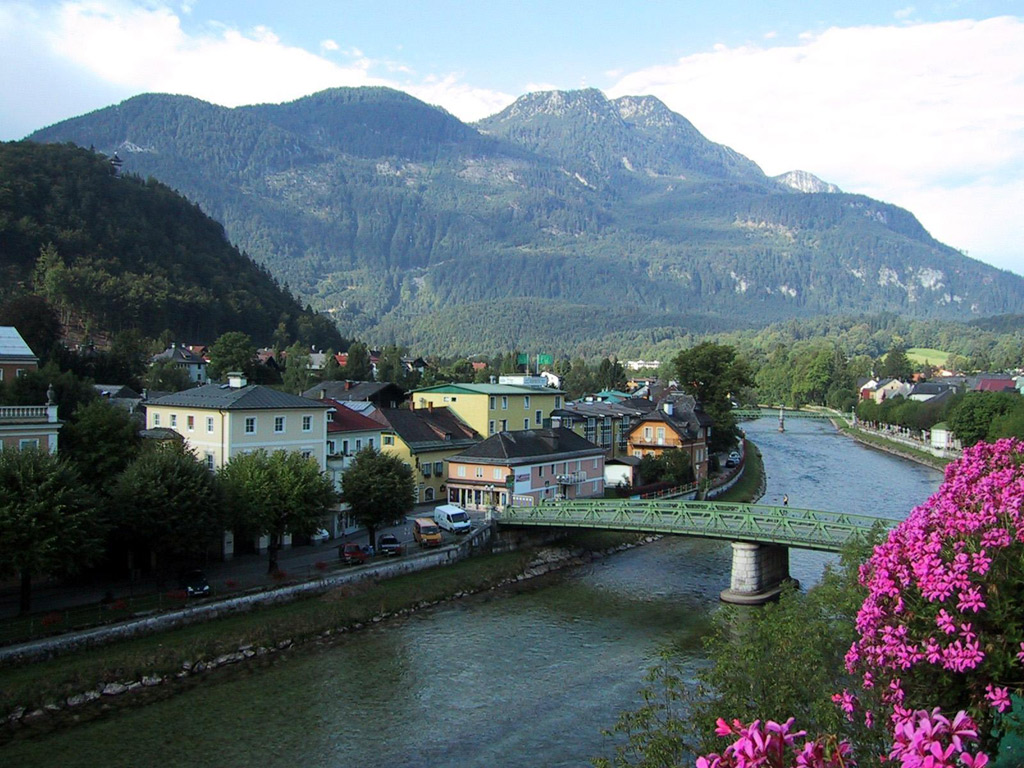
by Steve Cohen
Bad Ischl is a charming town that deserves to be better known. Rich in history and beautiful in scenery, it is now also the site for an annual festival of operetta.
Just a short drive from Salzburg, Bad Ischl does not have the cache of that other Austrian city with its own summer festival. But what it lacks in world-wide publicity, Bad Ischl makes up with the charm of being quiet, unspoiled and off the beaten track.
It is in Upper Austria, on the Traun River, and is proud of its thermal spas, its connection with Habsburg royalty and with operetta history and culture.
Operetta, of course, is that genre of musical theater that stresses sentiment and melody. It gained tremendous popularity between the mid-1800s and the mid-1900s with shows written by Johann Strauss, Franz Lehar, Oscar Straus, Emerich Kalman and two men who moved from Austria to America where they made their reputations on Broadway — Rudolph Friml and Sigmund Romberg. Many of these composers spent summers at Bad Ischl and, appropriately, the local celebration was re-named the Lehar Festival in 2003. Actually the operetta festival has been attracting fans here since 1998 when it opened with performances of Strauss’s Gypsy Baron.
The spokesperson for the Lehar Festival reminds us that the Austrian philosopher Karl Kraus once characterized operetta as a form of art in which “reality has been suspended and singing as a means of communication has been sanctified”, in which “music functions as a means to relieve people from the daily traumas of life and relaxes the mind.”
Lehar described Bad Ischl as the best source of ideas and inspirations possible. He wrote 40 operettas and operas, including The Merry Widow, Land of Smiles, The Count of Luxembourg and Giuditta, plus marches, dances and violin concertos. Born in Hungary, he died in Austria in 1948. His villa in Bad Ischl has been turned into a museum.
My family and I enjoyed a fun production of Strauss’s Eine Nacht in Venedig (A Night in Venice) in the large modern auditorium, KongressHaus. The cast was mostly young and the staging was inventive. This is far from the stodgy productions with aging singers that marked the years of operetta’s declining glory in America in the 1940s and 50s. Contact the Festival at its website, www.leharfestival.at.
The following day we strolled the streets of the town and took in some of the sights. Most impressive in the Kaiservilla, set back in the woods. This was the summer home of Emperor Franz Josef, the ruler of the Habsburg Empire from 1848 til his death in 1916. The Kaiservilla is rustic and relatively simple, with antlers mounted on the lodge’s walls.
Mineral-packed salt water springs were found in Bad Ischl in the early 1700s and this led to the establishment of a spa where wealthy folk, like royalty and composers, came to be cured of their aches and pains. The small village became fashionable.
It was in Bad Ischl in August of 1853 that the 23-year-old Emperor met the 15-year-old Princess Elisabeth of Bavaria and fell in love with her. They married and became parents of two sons and a daughter.
The Emperor, however, sometimes enjoyed the company of a young actress named Katherina Schratt at Bad Ischl while his wife was traveling around the realm. Elizabeth, commonly known as Cissy, particularly liked to vacation in the Mediterranean and built a dream villa on the island of Corfu. Franz Josef would walk the streets of Bad Ischl, nodding and smiling to his subjects. His favorite hang-out was Zauner’s coffee house, established in 1832. It still thrives today, and we spent an hour there sampling decadent deserts and sipping frappes. A local peculiarity is the fact that pet dogs are welcomed inside restaurants, so we saw matronly ladies sitting with their pets who wore elaborate neckbands and, sometimes, little caps.
It also was in Bad Ischl where the Emperor received news that Serbia rejected Austria’s ultimatum in 1914 following the assassination of Franz Josef’s nephew and heir-apparent, Franz Ferdinand. The old Emperor said: “Very well then” and signed the military mobilization order that started World War I. He was told by his advisers that resistance would be negligible and Serbia could be overrun within three weeks.
Two years later, with the world still at war, Emperor Franz Josef died at the age of 84 of heart failure. Katherina Schratt came and laid two white roses on his chest as he lay in state at Schonbrunn Palace.
A picturesque river runs through the center of town. With a cable car you can reach the summit of Katrin mountain and see a great view of the region. And an added attraction is the sight of local residents who choose to wear dirndles, liederhosen amd alpine hats with fancy feathers. Once each year, on the anniversary of Franz Josef’s engagement to Cissy, locals parade in their finest outfits.
While here, you can pretend that you are royalty and indulge yourself with thermal baths and massages at the KaiserTherme. Oriental Alhambra baths, steam baths and brine baths are among the specialties. Rooms are available for overnight lodging. Autographed photos of some of the spa’s thankful clients hang on the lobby wall. Among them, in addition to the operetta composers, are Johannes Brahms, Anton Bruckner, Giacomo Meyerbeer and Anton Webern.
I recommend renting a car to travel around this region. AutoEurope made excellent arrangements for us (call 800-223-5555). In their Audi we were able to set our own schedule of driving from Salzburg through the Lake Region, making leisurely stops at Lake Wolfgang and other charming towns on our way to Bad Ischl. You could retrace the road back to Salzburg in an hour or two. (It is 40 km away.) We, however, drove on across the heart of Austria to Vienna. That city is the subject of our next report.
Read other stories on The Cultural Critic